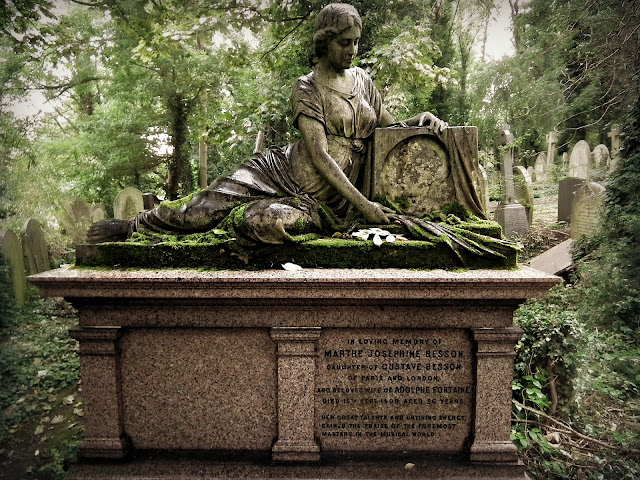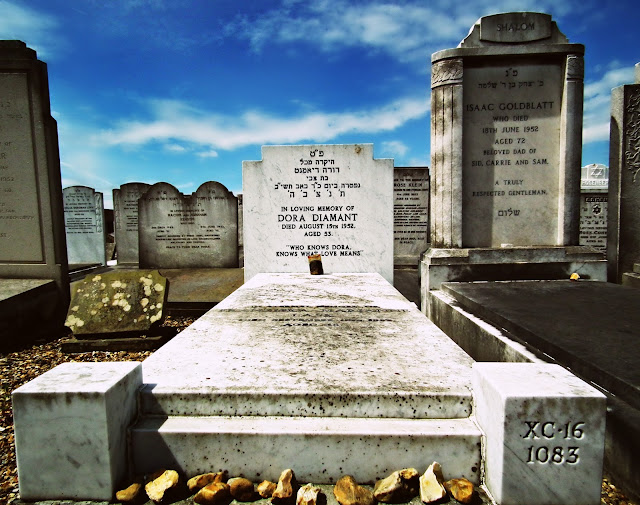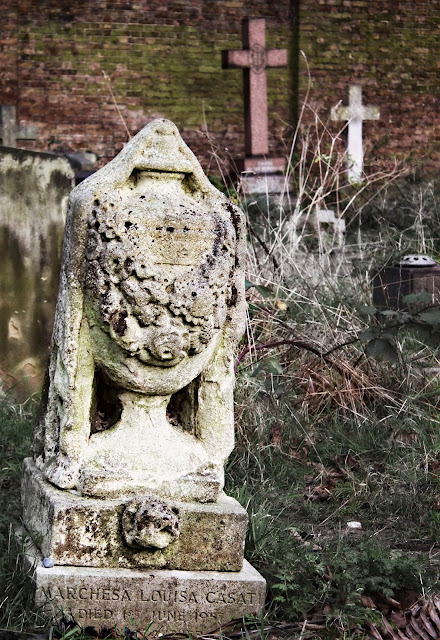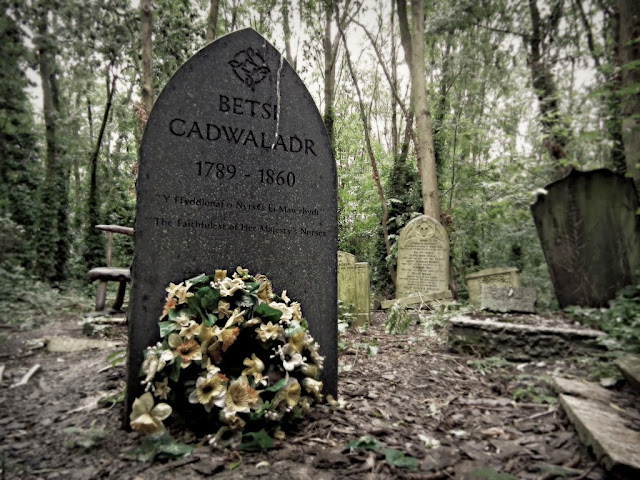For
International Women’s Day the London Dead would like to share some of its
favourite memorials in London cemeteries and remember the intriguing women they
commemorate. Cemeteries were (are) no less patriarchal than the rest of society
so women long received unequal treatment and almost always second billing to
their husbands. Women were viewed as nothing more than an adjunct to the
significant male in their lives and recorded on tombstones as ‘daughter or wife
of…’ (or even worse ‘relict of…’). But of
course, many women were much more interesting than the boring old fucks they
were married to; this is a selection of women who steadfastly refused to play
second fiddle.
Anne
Maria Lucena (1834-1908), Lavender Hill Cemetery, Enfield
The
memorial shows solicitor Stephen Lancaster Lucena’s second family in a
sentimental grouping with the two children Stephen and Annie Elizabeth being
read to by their mother Anne Marie, quite probably from the bible or some other
religious book as the little girl is clearly praying. Even the dog seems
attentive to the word of God. The domestic group was originally watched over by
a pair of guardian angels but only one is now in situ, the other, toppled from
its base, now lies headless and wingless behind the monument, the head is
completely missing but the broken wings are tucked into a niche on the main
memorial for want of any better place to put them. The piety of the sculptured group conceals a
series of late Victorian and early Edwardian scandals; both of the children
were conceived outside of wedlock, their mother a household servant in their
father’s house and in later life the praying little girl, Annie Elizabeth, went
through a spectacularly messy divorce from an army major which resulted in the
murder of her mother and the suicide of her ex-husband.
Anne Maria Benn met her future husband when she was 27 and working with her mother Hannah as domestic servants in the 56-year-old lawyer’s house, Rose Cottage, in Enfield. She became pregnant by her employer and went to have two children with him. He married her in 1874, three years after his first wife died and just two years before he died himself. Anne Maria put her husbands modest fortune to good use and turned herself into a very rich woman by property speculation. Her wealth failed to protect her from her psychologically damaged and brutal son-in-law who ordered her in 1908. Full story here.
Marthe
Josephine Besson (1852-1908), Highgate East Cemetery
Up
a steep and neglected muddy side path in Highgate East Cemetery, hidden amongst
the undergrowth and surrounded by toppled and leaning gravestones, you will
find this striking monument to a Victorian businesswoman. The inscription
reads:
In loving memory of
Marthe Josephine Besson,
daughter of Gustave Besson
of Paris and London
and beloved wife of Adolphe Fontaine.
Died 15th Sept 1908, aged 56 years.
Her great talents and untiring energy gained the praise of the foremost masters in the musical world.
It looks like a touching tribute from a grieving husband and one could lazily assume that Adolphe and Marthe were mutually devoted and lived long and contentedly in conjugal bliss. But one would be wrong. 12 years earlier Adolphe was trailing through Europe after Marthe and her Spanish lover accusing her of stealing his fortune, trying to have her arrested by Scotland Yard and generating a scandal that he must still have been trying to live down when he instructed A. MacDonald & Co. Ltd of Euston Road to produce his wife’s funeral monument.
Marthe certainly did not love Adolphe and would have been furious to see his name on her spectacular memorial. An astute business woman whose life was blighted by tragedy, Marthe was a strong willed woman who knew her own heart. Full story here and further details here.
Dora Diamant (1898-1952) United Synagogue Cemetery, Marlow Road, East Ham
In
the bed directly opposite me a woman lies dying. An older woman. She’s
whimpering incessantly, trying to say something. The nurses are trying to
understand what she says. Earlier on she cried. She lay quite still and the
tears flowed from her closed eyes down her face. A beautiful woman, fairly
plump, cheeks a little pink, maybe she has a fever. What does she think? Does
she know she is dying? She seems to be conscious. Then she certainly knows it.
It is simply not something one cannot overlook. I was not as far gone a few
weeks ago, but still I knew exactly how things looked....She is an Englishwoman
so at least she is dying in her homeland. .......(Later, when the nurses had moved
screens around the dying woman’s bed) I think it is the end over there.
It is difficult to think about anything else. Now and then one hears laughter
from the other end of the ward. On the whole most are quiet, not depressed,
although they too think of nothing else it seems.
Dora
Diamant, Plaistow Hospital April 1951
At
53 Dora Diamant was hardly old but she knew she was dying. She had been
diagnosed with chronic nephritis, a condition which eventually causes kidney
failure and for which there was no known cure. The disease could have killed
her at any time; the only suggestion her doctors had to prolong her life was
bed rest and a strict diet with restricted salt and protein. Even then they
couldn’t tell her if she had years, months or just weeks to live. She was
almost frantic with worry about her seventeen year old daughter, a beautiful
but unworldly child who had spent most of her sheltered childhood in hospitals
and boarding schools and was so shy that she could barely bring herself to
speak to strangers. How would she cope with life without her mother to look after
her? Her other preoccupation were her memories of her first lover, Franz
Kafka. Death would erase them unless she committed them to paper. On
March 4 1951 in black ink , she wrote across the front cover of a bright red
Silvine school exercise book ‘To be given to Max Brod’. On the inside cover she
wrote her address ‘Ward Pasteur 1, Plaistow Hospital, E15’ (Dora lived in
Finchley and so can be excused not knowing Plaistow Hospital was in E13 not
E15). In the blank pages of the exercise book she took herself back to
the summer of 1923 and the seaside town of Graal-Müritz on the Baltic coast,
the place where as a 25 year old volunteer at the Berlin Jewish People’s
holiday camp for refugee children, she had met and fallen in love with
Kafka.
Full
story here.
Marchesa
Luisa Casati (1881-1957), Brompton Cemetery
“Quite
suddenly and simply by chance, I once met a bizarre lady while taking tea with
some friends in London. She arrived wearing black velvet from head to foot, her
mouth painted blood red, and carrying a very tall umbrella with a decorated
handle. And, you must understand, this ensemble was being worn in the middle of
the day. This picturesque ruin of a woman was very tall and thin, and gave the
impression of formidable strength. It was then I was introduced to the Marchesa
Luisa Casati for the first and last time. She had made her entrance into that
room looking wonderful and saying very little. She wasn’t beautiful—she was
spectacular. Here was a woman possessing a presence one would never forget.”
Quentin Crisp
Full
story here
Moura
Budberg (1892-1974) Chiswick New Cemetery
In
her final years Moura Budberg lived in a ‘large rambling flat’ in the Cromwell
Road according to Michael Blakemore, who visited her at the request of Sir Laurence
Olivier, ‘attended by a female servant, also Russian…and equally cranky… Moura
had on a long dress, by no means new, but appropriate to a countess, and her
grey hair, its colour improved by the application of some silvery liquid was
swept on top of her head. A tiny metallic trickle ran down the side of her
face.’ According to other sources she was swollen and arthritic, kept a half
bottle of vodka in her handbag, passed her time making small bets on horse
races at Ladbrokes or watching Pinky and Perky on television and, as she was
perpetually short of money, shoplifting (for which she was arrested at least
once). The former beauty still craved company and in his memoirs, Alan Ross
recalls that her ‘entertaining, helped along by various Russian acolytes, was
now much reduced but invitations were peremptory. Any excuses… were brushed
aside as if of no account. “Just come in for a little moment,” she would
wheedle in her husky voice, which remained distinctive and seductive long after
all other physical charms had fled and she had become heavily square in shape.’
Another acquaintance, William Shier, tells us that two or three years before
she died, she was beginning to sort ‘through piles of material from cardboard
boxes that littered the living and dining rooms of her house in Cromwell Road
after she had given in to the pleas of her friends to write her memoirs.’ The much-requested memoir was never written,
‘the work seemed sometimes to bore and exhaust her and she would telephone
urging me to come over for tea and vodka.’ In 1974 Moura moved to Italy to live
in the sun, with her son, but died a few months later. Her body was shipped
back to England and after a funeral ceremony at the Cathedral of the Russian
Orthodox Church in Exile at Emperors Gate (just off the Cromwell Road, close to
Moura’s old flat) she was buried at the uninspiring Chiswick New Cemetery in a
small patch of other Orthodox burials.
Full story here.
Joyce
McQueen (1934-2010) Manor Park Cemetery
The
night before Joyce McQueen was due to be cremated at Manor Park Cemetery her
husband Ronald and the couple’s children had to decide whether to postpone the
funeral to give them time to organise a double interment. Joyce and Ronald’s
youngest son Lee (better known to the world at large as Alexander McQueen,
haute couturist) had been found dead at his home in Mayfair after apparently
hanging himself in a fit of depression brought on by his mother’s death. They
probably had no real choice but to go ahead with Joyce’s funeral as planned; if
Alexander had committed suicide they may have had to wait some time for his
body to be released by the coroner.
Full
story here.
Elizabeth
Alice Frances Hawkins-Whitshed (1860-1934) Brompton Cemetery
Although
we know, courtesy of the newspapers, exactly what the newly married Mrs Elizabeth
Burnaby was wearing when she set off on honeymoon (‘The bride’s travelling
dress was stone-coloured cashmere, trimmed with satin to match, a white chip
bonnet, and long white feather’), the only thing we know about the honeymoon
itself is that Lizzie came back pregnant and that she and her husband were
barely on speaking terms. They lived in London, together, until the birth of
their only child, a boy, but before they could celebrate their first wedding
anniversary Lizzie had moved to Switzerland ‘for the sake of her health.’ The
presumptive consumptive startled everyone by taking up mountain climbing,
something almost unheard for a woman in the dying years of the Victorian age.
The cosseted ward of the Chancellor discovered unimagined freedom in the
mountains, including the hitherto novel experience of putting “on my own boots,
and I was none too sure on which foot should go which boot. It is difficult for
me to realize now that for several years longer it did not occur to me that I
could do without a maid … I owe a supreme debt of gratitude to the mountains
for knocking from me the shackles of conventionality, but I had to struggle
hard for my freedom. My mother faced the music on my behalf when my grand-aunt,
Lady Bentinck, sent out a frantic S.O.S. ‘Stop her climbing mountains! She is
scandalizing all London and looks like a Red Indian.’” As well as being sunburnt Lizzie climbed in
pragmatic short skirts which barely came down to her knees, to her scandalised
contemporaries, practically naked in other words.
Full story here.
Betsi
Cadwaladyr 1789 - 1860, Abney Park Cemetery
The
penniless and obscure Betsi Cadwaladr was buried in 1860 in Abney Park Cemetery,
either laid above, below, or sandwiched between, three complete strangers in a
pauper’s grave dug deep enough to take four cheap coffins. There were probably
not many mourners at her funeral and no marker or memorial was erected over the
burial spot. The headstone now over her
grave is new, put up in 2012 by the Royal College of Nursing and a Welsh Health
Board that had adopted her name and proclaimed Betsi a Welsh national heroine. Not everyone was
pleased to see the obscure Betsi Cadwaladr, or Elizabeth Davies as she was also
known, launched into posthumous celebrity. In Wales there were dark mutterings
accusing the former nurse of having worked as a prostitute in the Liverpool
Docks; in January 2012 the Welsh Daily Post felt obliged to defend her honour
against her detractors and calumniators, retorting that there was no evidence
that she had ever sold herself on the streets of Merseyside.
Full
story here








Hope you are well. I've enjoyed your blog for over a year and look forward to reading more. Take care and Thankyou
ReplyDeleteI'm good thank you and hope you are too? Thank you for your kind comments; I'm always really pleased to hear that anyone take an interest in this blog!
Delete